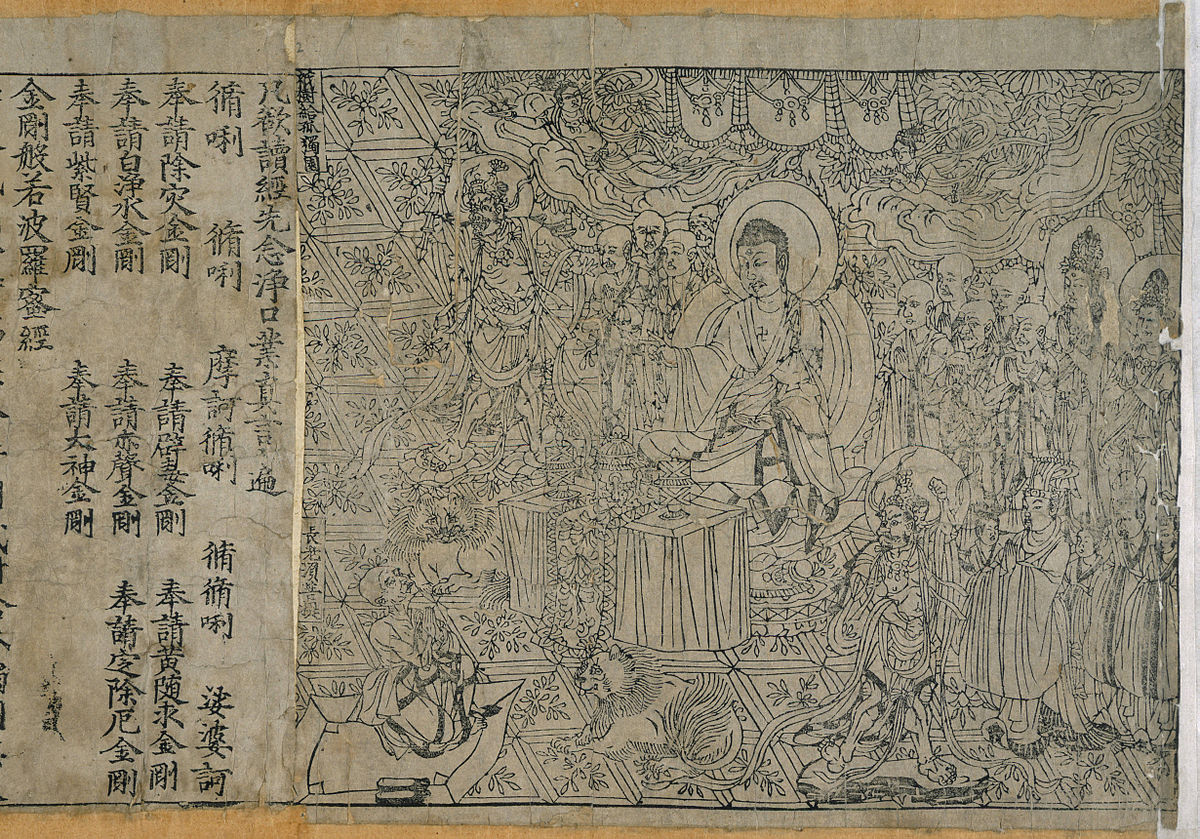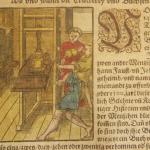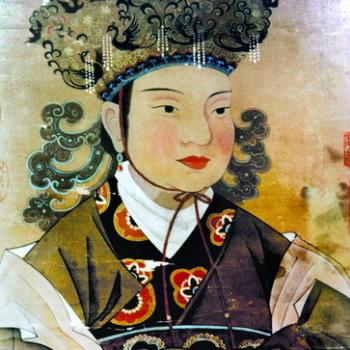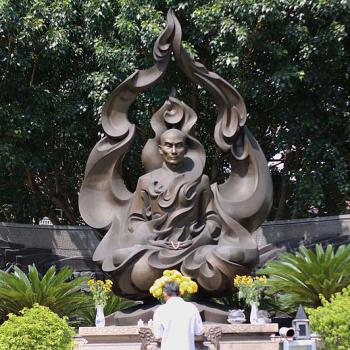Religion stumbled along for centuries before the invention of printing technology. Before printing was invented, scriptures had to be copied by hand. Sometimes they were memorized and chanted. But then came printing, and Bibles and sutras and sermons and all manner of religious expression could be easily published and mass distributed. But what was the impact of printing on religion? It varied. In Asia, printing tended to support religion. But elsewhere — especially Europe — the introduction of printing technology was like a bomb that completely changed the religious landscape.
The history of print technology begins in China. Chinese culture going back to even before Confucius (ca. 551-479 BCE) placed great importance on scholarship and mastery of the Chinese classic texts. Such mastery signified a superior person. Eventually the list of classics came to include the philosophical treatises of great Confucian and Daoist scholars and many scriptures and commentaries of Buddhism. So it makes sense that the Chinese would be first to come up with more efficient ways to produce copies of important works.
Paper as we know it today was invented about 150 CE by Cai Lun (or Ts’ai Lun), an official of the Han Dynasty Imperial Court. Many cultures from earliest history made many kinds of inks, but the high-quality ink known as India ink was invented in China, possibly about the same time as the invention of paper. And the Chinese also began printing long texts from inked wooden blocks carved in relief a long time ago. We know this was being done by the year 700 or so, and possibly earlier.
The Oldest Printed Scripture
If you asked most westerners to identify the oldest printed and dated book, they’d probably guess it was the Gutenberg Bible (ca. 1455). But the oldest extant printed and dated book — well, scroll — is of another scripture, the Diamond Sutra, printed in China in the 9th year of the Xiantong Era of the Tang Dynasty, or 868 CE. The Diamond Sutra (in Sanskrit, the Vajracchedikā Prajñāpāramitā Sūtra) is one of the most revered Buddhist scriptures in east Asia and Tibet. It was first translated from Sanskrit into Chinese by Kumarajiva about the year 400 CE.
A dedication on the scroll says, “Wang Jie had this made for universal distribution on behalf of his two parents.” Wang Jie probably hoped that distribution of the sutra would make merit for his parents and give them a fortunate rebirth. How many other copies were printed, and what happened to the rest of them, is not known.
The year 868 was not a stable time in China. The once-mighty Tang Dynasty was nearing its end. By the 870s gangs of bandits and rebels were defeating the Emperor’s mutinous armies. Cities and temples were being sacked. Much was lost. We can only hope for the best for Wang Jie and his parents. But how was the one copy preserved?
An Amazing Archeological Find
In 1900, a Daoist monk discovered a long-hidden door in a cave complex in Dunhuang, China, in modern day Gansu Province. Behind the door was one of the most significant archeological finds of modern times—a library of tens of thousands of scrolls and other documents that had been untouched for at least nine hundred years. Thanks in part to the dry climate of the region, the scrolls were well preserved. And soon European and Japanese curators descended on Dunhuang to scoop up treasures for their museums.
One of the treasures was the Diamond Sutra scroll, which is now in the British Library in London. The British library tells us that “Each section of the scroll was printed separately, by using a single wood block, and then joined to the others in order to form a 5-metre long horizontal roll.” Carving the wood blocks must have taken astonishing skill.
The First Movable Type
Movable type refers to using many individual pieces of type — individual letters of the alphabet, or the logograms of written Chinese — to set printed pages. The many bits of type are made so they can be assembled and reassembled on a flat bed to print many different texts. Movable type was first created in China by Bi Sheng (990-1051). However, Bi Sheng made his characters with porcelain, which was fragile. Other printers tried carved wood. By 1161 the Chinese were printing paper money using metal movable type, and perhaps some books were published that way also. However, the oldest extant book known to have been printed with metal movable type is from Korea. The book, the Buljo jikji simche yojeol, or “Anthology of the Great Buddhist Priests’ Teachings,” presents teachings of Seon Buddhism, or Korean Zen, and it was printed in 1377.
For the next few centuries printing in east Asia would be done partly by use of movable type and partly by carved blocks. The carved blocks tended to be less expensive, especially since classic texts and scriptures could be printed over and over for many years from the same blocks.
Publish or Perish in the Song Dynasty
However works were typeset, mass printing during China’s Song Dynasty (960-1279) turned out to be important for the survival of Chinese Zen, called Chan. At the time, Chan was the dominant school of Buddhism in China, but the Song emperors were mostly Confucians who were ambivalent about Buddhism. And at the time, temples of any tradition survived by imperial consent and patronage.
The first Song emperor, Taizu, may have been ambivalent about Buddhism but he was keenly interested in literacy. Taizu nurtured and encouraged a class of educated men called the shidafu, “scholar-officials” or “literati,” to fill the government’s bureaucracies. And it appears the shidafu developed a roaring appetite for new things to read.
Chan Buddhism published a huge body of its classic literature in this period. This gave Chan a following, and supporters, among the shidafu. In his book How Zen Became Zen (University of Hawaii Press, 2010), the scholar Morten Schlütter wrote, “Chan masters were very much aware that the publication and spread of its literature was essential for the success and survival of the Song Chan school and for their own careers.” It was publish or perish, so they published. Zen Buddhism — which began in China and then spread to Korea and Japan and eventually everywhere — may not have survived to this day without all that publishing.
Printing the Sutras in Japan
One more story about printing in Asia — Japan was slow to adopt Chinese print technology, which is surprising because the Japanese borrowed much else from Chinese culture. As late as the 17th century the only Buddhist scriptures in Japan were copied by hand and kept in temples and monasteries.
In about 1663 a monk named Tetsugen Doko (1630-1682), of a school of Japanese Zen called Obaku, was traveling in Japan lecturing on the sutras. He realized that most laypeople in his audiences had no access to sutras, so most people could not read them in spite of the generally high rate of literacy in Japan. So Tetsugen became determined to publish the sutras using the carved wooden block technique. This was a huge undertaking, because there are a lot of sutras in the Japanese Buddhist canon. Someone had attempted to publish the sutras before, but the effort was flawed and only a few copies were made.
So, Tetusgen began by raising money to pay for the skilled woodcarvers and editors and materials. He even begged in the streets to raise money. Finally an “advance” copy of the work was ready to present to the Shogun, Tokugawa Tsunayoshi, but for some reason Tsunayoshi would not receive Tetsugen. And publication could not continue without the Shogun’s approval. Tetusgen died in 1682. His disciple Hoshu finally got the Shogun’s permission to begin printing in 1690.
Tetsugen’s Three Editions
So it was that the sutras were published in Japan. The meticulously prepared carved wooden blocks were used for many years to print more copies of sutras. Tetsugen’s sutras became the standard Buddhist canon in Japan. The original wooden blocks are still reverently preserved in Manpuku-ji, the Obaku main temple in Kyoto.
A story is told that I could not confirm as history, but it might be. When Tetsugen first raised money for the canon, he learned of a flood in Osaka that had left many people homeless. So he spent the money to provide for the destitute, and he started over to raise money for the sutras. He had reached his goal a second time when a great famine occurred, so he spent the money on food for the hungry. Finally, he raised the money a third time, and those funds were used to publish the sutras. It was said ever after that Tetsugen had published three editions of the sutras, but the first two editions exceeded the third.
For more stories of Zen history, see my book, The Circle of the Way: A Concise History of Zen from the Buddha to the Modern World (Shambhala, 2019).
Next: Movable type reaches Europe. First came the Gutenberg Bible. Then came the Reformation..














